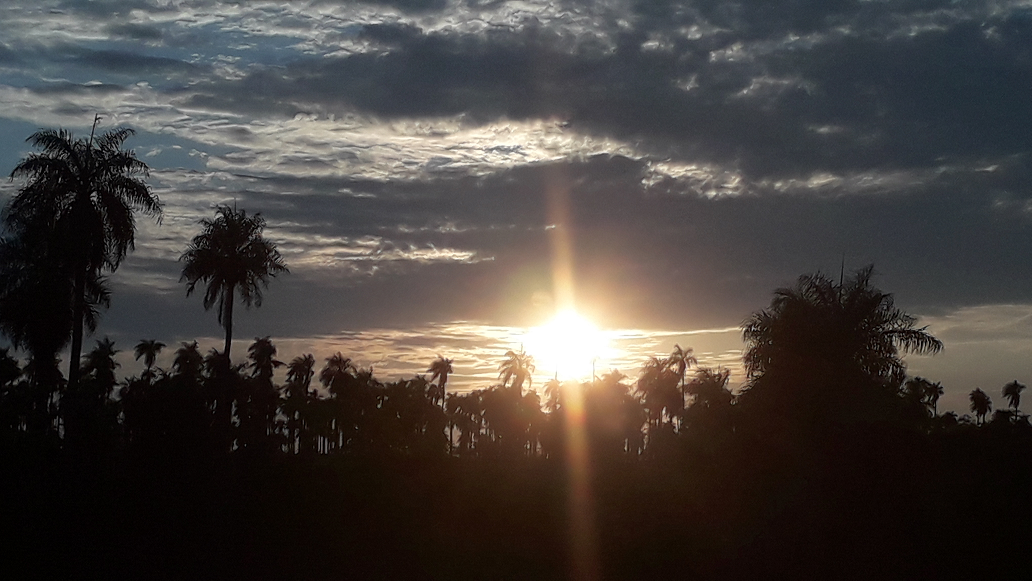Clear skies in Paraguay mean that almost every day ends with a fine sunset. The only exceptions being the cloudy days when a storm roils through.
I live out in the countryside and so in addition to the clear skies the view is unobstructed by buildings.
In common with everywhere else in the world the sun sets in the west in Paraguay. To the west of my house there is gentle rise along which palm trees grow. This acts in enhance the already fine daily event which is sunset.
The timing of sunset varies throughout the year and the days lengthen and shorten with the changing seasons. In mid winter the sunsets about 4pm and there is no evening at all.
Now however in mid summer it is setting much later. It is almost 8pm before the sun vanishes from sight giving a couple of fine evening hours.
Whatever the time of year and a whatever hour the sun falls from view the setting sun is always a splendid sight.
As the end of the afternoon approaches the sun begins to sink in the western sky. Slowly the distance between the sun and the horizon shortens.
With the land rising to the west of my house the sun vanishes from view before sinking below the true horizon. Doing so the sky it lit for a while by an unseen sun unlit night arrives bringing its darkness.
The sky is filled though with colour long before that happens. Long before the sun vanishes from view.
As the sun descends towards the tops of the palm trees that line the ridge its light is low enough to light clouds from below.
Often late afternoon there is a thin layer of hazy cloud high up in the sky. This is moisture held in the hot air that is slowly condensing as the temperature drops a little with the retreat of the sun.
These thin clouds form bands across the sky. These bands reflect orange, red, blue or black as the light from the setting sun falls upon them.
Being delicate clouds they are constantly on the move. Rearranged by thermals, air currents and winds into ever changing patterens.
Watching the daily light show differences are visible from minute to minute. Sometimes large, sometimes just subtle. Always though on the move for sunset is never static.
Initially the colours are light and soft. Mainly soft oranges and blues. Always though there are darker patches of sky.
On occasions is the conditions are just right the sky may for a while turn bright purple.
As the sun continues to sink. First touching the ridge line and then falling below it the colours and the sky darken. Red become more prominent than orange and black more common than blue.
Still however the light show continues. Bands of colour still sweep across the sky from horizon to horizon. On occasion the whole sunset may appear like a giant red fireball burning from the ground to the high heavens.
Furthermore if the conditions of cloud and light are just right the glow of the sunset my escape far beyond the western sky.
At these times reflected light colours the whole sky. This escaping sunset reflects orange. When that happens the air itself seems to turn orange.
This strange orange sky seems heavier than a clear sky. Much like the distorted and altered air caused by an eclipse it has a unique feeling to it. Everything seems still and quiet and the land takes on a different character.
As with an eclipse the effect lasts just for a short while. Unlike an eclipse though it will be repeated whenever the atmospheric conditions are right and not just when the calendar demands.
Once the sun has fallen from view it takes a while for night to truly arrive.
The thin clouds melt away and as the sky darkens stars appear one by one.
Gradually more and more stars light up. Slowly they fill the night sky illuminating the constellations and the Milky Way as they do.
After an hour or so the transition from day to night is complete. By then stars display as thousands of points of light in the night sky.
Slowly these move across the night sky as the Earth rotates below. Then they will start to fade as the rotation brings about a glow in the eastern sky and the start of another day.


Very interesting reading Simon